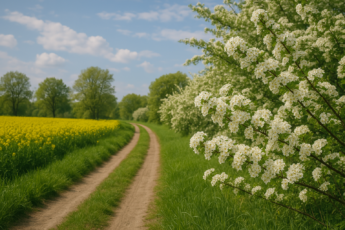With the arrival of spring, the Polish nature comes to life, and the rivers undergo fascinating metamorphoses. Some take on a milky -white shade, others shimmer with turquoise glow, and others, like the legendary Biebrza, seem to spill like hot wine. Is it a whim of nature, or is it the effect of a specific chemical process? It's time to solve this puzzle and discover where in Poland you can see these spectacular phenomena.
Biebrza spring backwaters - a natural theater of water and life
The Biebrza River is a real queen of spring changes. Her picturesque valley, extending to hundreds of kilometers, turns into one big lake at the beginning of the season of melting snow. The water level increases rapidly, and peat bogs and meadows are drown in wide backwaters. Although the water itself does not change color, light, the angle of incidence of sunlight and the wealth of organic matter make it reflect shades of red, copper and orange.
This is a real feast for nature lovers. Bird concerts, floating fog at dawn and endless water mirrors make it one of the most unusual phenomena in Europe.
Turquoise Dunajec - the effect of mountain minerals
Dunajec, one of the most picturesque Polish streams, takes on an intense turquoise color in spring. This is not magic, but pure chemistry - water rinses calcium carbonate from Pieniny calcareous rocks, creating an amazing optical mix. The light breaks down in the water, and we see its blue and greenish shades. The best way to admire this spectacle is Dunajec rafting - traditional rafting rafts allow you to admire this phenomenon from the first row!
Augustów Canal - a crystalline oasis in the heart of the forests
The Augustów Canal, connecting the Vistula and Nemunas basins, in spring becomes one of the most beautiful places to admire the reviving nature. Surrounded by thick forests, it has almost crystal clear water, which makes him a sensation on a national scale.
A walk along its banks or a kayak cruise allow you to immerse yourself in this picturesque scenery. An interesting fact is that in some sections of the canal water adopts an emerald color - this is the result of a reflection of the surrounding greenery and a specific mineral composition.
Why do rivers change color?
Changing the color of rivers is the result of many factors - both biological and geological. The most important are:
- Melting snow - an increase in water levels causes backwaters and leaching mineral sediments.
- Mineral compounds - calcium, iron or humic acids affect the color of water.
- Microorganisms and algae - some rivers change color to green or red due to the blooming of algae and microorganisms.
- Lighting and angle of light - some rivers seem more intense in color with a certain light.
How and when is it best to observe these phenomena?
If you dream of seeing rivers with unusual colors with your own eyes, here are some practical tips:
- The best time to go? March and April are the climax of spring changes.
- Where to go? Biebrza National Park for backwaters, Pieniny for Turkusowy Dunajec, Augustów Canal for Emerald Reflections.
- What to travel? Rafting on the Dunajec, kayak through the Augustów channel or walking around the Biebrza Valley - each option has its own charm.
Spring in Poland - a blaze of colors and natural performances
You don't have to go to exotic countries to see the water wonders of nature. Poland in spring can amaze and delight - just plan the trip to the right place.
Take the camera, binoculars and an open head - nature will take care of the rest. When Bieba spills, Dunajec shines with turquoise, and the forests are reflected in the Augustów channels, you know that you are witnessing something really special.






